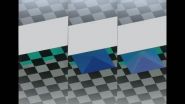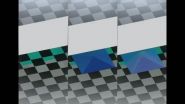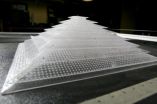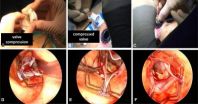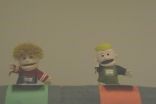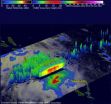(Press-News.org) VIDEO:
This video demonstrates the difference in how sound waves act with and without the acoustic cloak in their path. The red and blue lines represent the high and low points...
Click here for more information.
DURHAM, N.C. -- Using little more than a few perforated sheets of plastic and a staggering amount of number crunching, Duke engineers have demonstrated the world's first three-dimensional acoustic cloak. The new device reroutes sound waves to create the impression that both the cloak and anything beneath it are not there.
The acoustic cloaking device works in all three dimensions, no matter which direction the sound is coming from or where the observer is located, and holds potential for future applications such as sonar avoidance and architectural acoustics.
The study appears online in Nature Materials.
"The particular trick we're performing is hiding an object from sound waves," said Steven Cummer, professor of electrical and computer engineering at Duke University. "By placing this cloak around an object, the sound waves behave like there is nothing more than a flat surface in their path."
To achieve this new trick, Cummer and his colleagues turned to the developing field of metamaterials—the combination of natural materials in repeating patterns to achieve unnatural properties. In the case of the new acoustic cloak, the materials manipulating the behavior of sound waves are simply plastic and air. Once constructed, the device looks like several plastic plates with a repeating pattern of holes poked through them stacked on top of one another to form a sort of pyramid.
To give the illusion that it isn't there, the cloak must alter the waves' trajectory to match what they would look like had they had reflected off a flat surface. Because the sound is not reaching the surface beneath, it is traveling a shorter distance and its speed must be slowed to compensate.
"The structure that we built might look really simple," said Cummer. "But I promise you that it's a lot more difficult and interesting than it looks. We put a lot of energy into calculating how sound waves would interact with it. We didn't come up with this overnight."
To test the cloaking device, researchers covered a small sphere with the cloak and "pinged" it with short bursts of sound from various angles. Using a microphone, they mapped how the waves responded and produced videos of them traveling through the air.
Cummer and his team then compared the videos to those created with both an unobstructed flat surface and an uncloaked sphere blocking the way. The results clearly show that the cloaking device makes it appear as though the sound waves reflected off an empty surface.
Although the experiment is a simple demonstration showing that the technology is possible and concealing an evil super-genius' underwater lair is a long ways away, Cummer believes that the technique has several potential commercial applications.
"We conducted our tests in the air, but sound waves behave similarly underwater, so one obvious potential use is sonar avoidance," said Cummer. "But there's also the design of auditoriums or concert halls—any space where you need to control the acoustics. If you had to put a beam somewhere for structural reasons that was going to mess up the sound, perhaps you could fix the acoustics by cloaking it."
INFORMATION:
This research was supported by Multidisciplinary University Research Initiative grants from the Office of Naval Research (N00014-13-1-0631) and from the Army Research Office (W911NF-09-1-00539).
"Three-dimensional broadband omnidirectional acoustic ground cloak," Zigoneanu L., Popa, B., Cummer, S.A. Nature Materials, March 9, 2014. DOI: 10.1038/NMAT3901
Acoustic cloaking device hides objects from sound
Duke engineers build world's first 3-D acoustic cloaking device
2014-03-11
ELSE PRESS RELEASES FROM THIS DATE:
Scientists 'herd' cells in new approach to tissue engineering
2014-03-11
VIDEO:
Videos show the effect of electric fields on the movement of epithelial cells. The first clip shows the cells migrating normally until the electric field is turned on, causing the...
Click here for more information.
Berkeley -- Sometimes it only takes a quick jolt of electricity to get a swarm of cells moving in the right direction.
Researchers at the University of California, Berkeley, found that an electrical current can be used to orchestrate the flow of a group ...
Prosocial youth less likely to associate with deviant peers, engage in problem behaviors
2014-03-11
COLUMBIA, Mo. – Prosocial behaviors, or actions intended to help others, remain an important area of focus for researchers interested in factors that reduce violence and other behavioral problems in youth. However, little is known regarding the connection between prosocial and antisocial behaviors. A new study by a University of Missouri human development expert found that prosocial behaviors can prevent youth from associating with deviant peers, thereby making the youth less likely to exhibit antisocial or problem behaviors, such as aggression and delinquency.
"This ...
Finding hiding place of virus could lead to new treatments
2014-03-11
WINSTON-SALEM, N.C. – March 11, 2014 – Discovering where a common virus hides in the body has been a long-term quest for scientists. Up to 80 percent of adults harbor the human cytomegalovirus (HCMV), which can cause severe illness and death in people with weakened immune systems.
Now, researchers at Wake Forest Baptist Medical Center's Institute for Regenerative Medicine report that stem cells that encircle blood vessels can be a hiding place, suggesting a potential treatment target.
In the American Journal of Transplantation (online ahead of print), senior scientist ...
First human totally endoscopic aortic valve replacements reported
2014-03-11
Beverly, MA, March 11, 2014 – Surgeons in France have successfully replaced the aortic valve in two patients without opening the chest during surgery. The procedure, using totally endoscopic aortic valve replacement (TEAVR), shows potential for improving quality of life of heart patients by offering significantly reduced chest trauma. It is described in the Journal of Thoracic and Cardiovascular Surgery, an official publication of the American Association for Thoracic Surgery.
Endoscopic surgery is already used by cardiovascular surgeons for procedures such as atrial ...
No one likes a copycat, no matter where you live
2014-03-11
VIDEO:
One puppet peeks at another puppet's drawing because he can't decide what to draw, but he then draws a unique picture.
Click here for more information.
Even very young children understand what it means to steal a physical object, yet it appears to take them another couple of years to understand what it means to steal an idea.
University of Washington psychologist Kristina Olson and colleagues from Yale and the University of Pennsylvania discovered that preschoolers ...
Global survey of urban birds and plants find more diversity than expected
2014-03-11
AMHERST, Mass. – The largest analysis to date of the effect of urbanization on bird and plant species diversity worldwide confirms that while human influences such as land cover are more important drivers of species diversity in cities than geography or climate, many cities retain high numbers of native species and are far from barren environments.
Urban ecologist Paige Warren of the University of Massachusetts Amherst, co-leader of a 24-member research working group at the University of California Santa Barbara's National Center for Ecological Analysis and Synthesis ...
Diets high in animal protein may help prevent functional decline in elderly individuals
2014-03-11
A diet high in protein, particularly animal protein, may help elderly individuals function at higher levels physically, psychologically, and socially, according to a study published in the Journal of the American Geriatrics Society.
Due to increasing life expectancies in many countries, increasing numbers of elderly people are living with functional decline, such as declines in cognitive ability and activities of daily living. Functional decline can have profound effects on health and the economy.
Research suggests that aging may reduce the body's ability to absorb or ...
Substance naturally found in humans is effective in fighting brain damage from stroke
2014-03-11
DETROIT – A molecular substance that occurs naturally in humans and rats was found to "substantially reduce" brain damage after an acute stroke and contribute to a better recovery, according to a newly released animal study by researchers at Henry Ford Hospital.
The study, published online before print in Stroke, the journal of the American Heart Association, was the first ever to show that the peptide AcSDKP provides neurological protection when administered one to four hours after the onset of an ischemic stroke.
This type of a stroke occurs when an artery to the brain ...
NASA eyes 2 tropical cyclones east of Australia
2014-03-11
NASA's Aqua and TRMM satellites have been providing rainfall data, cloud heights and temperature and other valuable information to forecasters at the Joint Typhoon Warning Center as they track Tropical Cyclones Hadi and Lusi in the South Pacific.
NASA's Aqua satellite captured both storms in one infrared image on March 10 at 14:47 UTC/10:47 a.m. EST. At that time, Hadi was near the east Queensland coast while Lusi was several hundred miles north of New Caledonia. The Atmospheric Infrared Sounder or AIRS instrument captured infrared data that was used to create a false-colored ...
Alps to Appalachia; submarine channels to Tibetan plateau; Death Valley to arctic Canada
2014-03-11
Boulder, Colo., USA – On 27 Feb. and 6 Mar. 2014, GSA Bulletin published 11 articles online ahead of print, including two that are open access: "O2 constraints from Paleoproterozoic detrital pyrite and uraninite" and "Sediment transfer and deposition in slope channels: Deciphering the record of enigmatic deep-sea processes from outcrop." Other articles cover geological features in the Alps; the Appalachians; Death Valley; India; the Himalaya; the Columbia River Basalt Province; San Simeon, California; Kaua'i, Hawai'i; and artic Canada.
GSA Bulletin articles published ...
LAST 30 PRESS RELEASES:
Bharat Innovates 2026 National Basecamp Showcases India’s Most Promising Deep-Tech Ventures
Here’s what determines whether your income level rises or falls
SCIE indexation achievement: Celebrate with Space: Science & Technology
Children’s Hospital Colorado performs region’s first pediatric heart and liver dual organ transplant
Australian team discover why quantum computers have memory problems over time
What determines the fate of a T cell?
Candida auris: genetic process revealed which could be treatment target for deadly fungal disease
Groundbreaking discovery turns household plastic recycling into anti-cancer medication
Blocking a key inflammatory pathway improves liver structure and vascular function in cirrhosis, study finds
Continuous spread: Raccoon roundworm detected in nine European countries
HKUST Engineering researchers developed a novel photodetector to enhance the performance of on-chip light monitoring
Strategic river sensors could have forewarned of Texas Camp flood disaster
Drone sampling of whale breath reveals first evidence of potentially deadly virus in Arctic
Roman soldiers defending Hadrian’s Wall infected by parasites, study finds
Pinochet’s prisoners were tormented with music but still found solace in it, a new book reveals
Fertility remains high in rural Tanzania despite access to family planning
AI-assisted device can improve autism care access
Kinetic careers
Uncovering how parasitic plants avoid attacking themselves to improve crop resistance
Nanoparticle vaccine strategy could protect against Ebola and other deadly filoviruses
Study finds brain care score can predict risk of stroke across racial groups
Key lung immune cells can intensify allergic reactions
Do hormones explain why women experience more gut pain?
New materials conduct ions in solids as easily as in liquids
Breakthrough of the Year: Renewable energy begins to eclipse fossil fuel-based sources
LLM use is reshaping scientific enterprise by increasing output, reducing quality and more
Introducing LightGen, a chip for ultra-fast, ultra-efficient generative AI
Astronomers see fireworks from violent collisions around nearby star
ACC/AHA issue new guideline on managing congenital heart disease in adults
Cosmic crash caught on camera
[Press-News.org] Acoustic cloaking device hides objects from soundDuke engineers build world's first 3-D acoustic cloaking device
